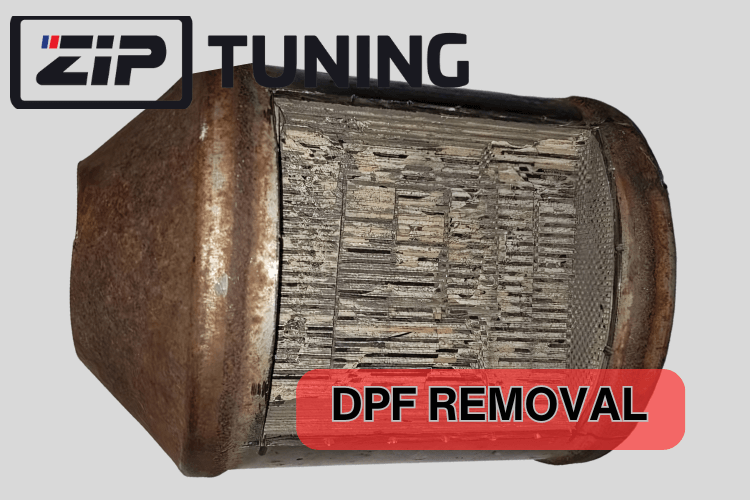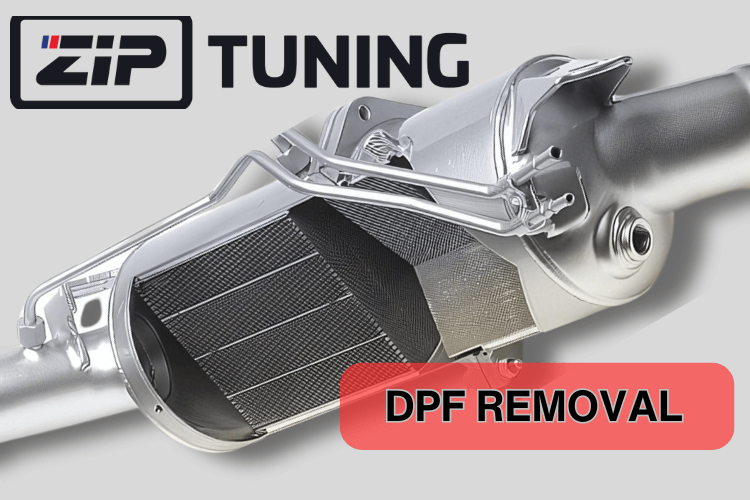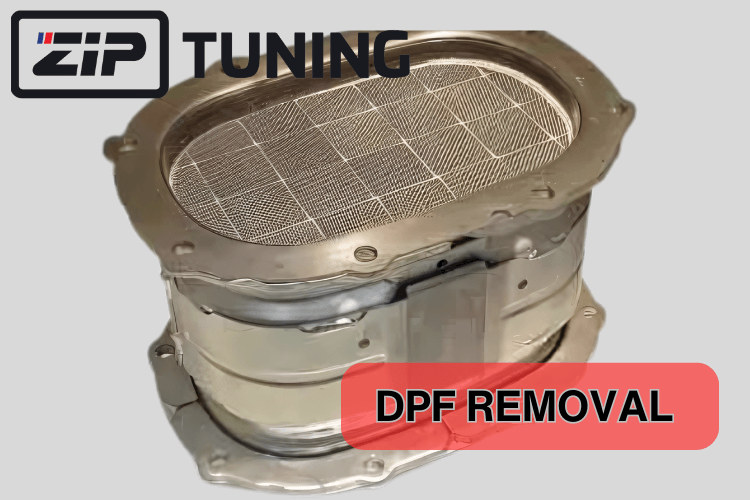DPF Delete
DPF Delete: detailed information & key modifications
As an automotive engineer specializing in engine calibration, it's crucial to understand the intricate process of modifying ECU software for DPF removal. This process involves altering several critical maps and parameters within the engine control unit. Here's a detailed breakdown of the key modifications:

1. DPF Regeneration Maps
- Function: Control the soot burn-off process in the DPF.
- Modification: Disable regeneration by zeroing out parameters or deactivating triggers.
2. Soot Load Maps
- Function: Monitor DPF soot accumulation and trigger regeneration.
- Modification: Set to constant low values or zero, preventing regeneration initiation.
3. Pressure Sensor Maps
- Function: Measure pressure differential across the DPF.
- Modification: Bypass or modify to show constant, low-pressure differential.
4. Temperature Maps
- Function: Monitor exhaust gas temperatures for DPF management.
- Modification: Adjust thresholds or disable monitoring to prevent regeneration triggers.
5. Diagnostic Trouble Code (DTC) Maps
- Function: Store DPF-related fault codes.
- Modification: Disable or remove DPF-related DTCs to prevent error messages.
6. Exhaust Gas Recirculation (EGR) Maps
- Function: Control EGR system, which interacts with DPF.
- Modification: Optimize EGR settings for performance without DPF, potentially reducing flow.
7. Fuel Injection Maps
- Function: Control fuel injection timing and quantity.
- Modification: Adjust for optimal combustion without DPF, potentially reducing soot production.
Advanced Considerations
Readiness and OBD-II Compliance
- Recalibrate DPF-related readiness monitor to always show "Ready" status.
- Ensure other readiness monitors function normally for OBD-II compliance.

Calculated Nominal Values (CNV)
- Recalculate CNVs to reflect new exhaust configuration:
- Adjust exhaust backpressure expectations
- Modify mass airflow sensor readings
- Update oxygen sensor feedback parameters
Pre-Removal ECU Preparation
- Clear all DPF-related fault codes
- Reset soot load counter to zero
- Clear regeneration history and interval timers
- Reset DPF ash accumulation counter
Professional Diagnostic Equipment
- Essential for successful modification and verification:
- OE-level communication capabilities
- Real-time data monitoring
- Advanced coding and flashing capabilities
Technical Process Workflow
- Customer registration and credit purchase
- ECU read-out by customer
- File upload to our service portal
- Engineer review for special requirements
- File modification and upload to customer portal
- Customer download and ECU flashing
- Support via ticket system as needed
Our efficient process ensures quick turnaround, typically under 30 minutes, with complex files processed within an hour.

Critical Considerations
- Emissions Compliance: DPF removal alters emissions profile; intended for off-road or racing use only.
- Engine Longevity: Calibrations optimized to maintain engine health despite DPF removal.
- Performance Gains: Potential improvements in horsepower and torque due to reduced backpressure.
- Legal and Environmental Impact: Consider local regulations and environmental implications before proceeding.
As professional calibration engineers, we ensure each DPF removal file is tailored to specific engine models, considering turbocharger specifications, fuel system capabilities, and overall powertrain architecture. This comprehensive approach maintains vehicle performance and reliability while achieving the desired modifications.
Need DPF-Delete tuning file?
FAQs
How do you modify the lambda sensor feedback loop to compensate for the altered exhaust flow post-DPF removal?
We adjust the lambda target values and modify the closed-loop fuel trim parameters to account for the increased exhaust flow. This often involves widening the acceptable range for short-term fuel trims and recalibrating the long-term fuel trim limits.
What strategies do you employ to prevent torque limiting when disabling DPF-related parameters in modern ECUs?
We modify the torque model within the ECU, adjusting the maximum allowable torque values and recalibrating the torque intervention thresholds. This often involves remapping the engine load calculation to prevent false overload conditions.
How do you address potential issues with EGR cooler efficiency after DPF removal, particularly in high-EGR rate engines?
We typically reduce the overall EGR rate to compensate for the increased exhaust gas temperatures. Additionally, we may modify the EGR cooler bypass strategies and adjust the EGR temperature thresholds to maintain optimal cooler efficiency.
What methods do you use to recalibrate the mass airflow sensor readings to account for the changed exhaust backpressure?
We adjust the MAF sensor scaling tables to compensate for the increased airflow. This often involves modifying the volumetric efficiency maps and recalibrating the air mass calculation algorithms within the ECU.
How do you modify the fuel injection timing and duration maps to optimize combustion efficiency without the DPF?
We typically advance injection timing slightly to take advantage of the reduced exhaust backpressure. Duration maps are adjusted to optimize air-fuel ratios across the entire RPM and load range, often resulting in slightly leaner mixtures.
What approach do you take to disable DPF regeneration cycles without triggering failsafe modes in the ECU?
We disable the regeneration triggers by modifying the soot load calculation algorithms and setting fixed values for DPF-related sensors. Additionally, we may need to bypass certain safety checks within the ECU to prevent failsafe modes.
How do you handle OBD-II readiness monitors for emissions-related systems after DPF removal?
We modify the readiness monitor completion criteria for DPF-related tests, setting them to always show as “complete.” For other emissions systems, we adjust the monitoring parameters to ensure they continue to function correctly despite the altered exhaust configuration.
What strategies do you employ to prevent excessive exhaust gas temperatures in the absence of the DPF’s heat-absorbing properties?
We modify the fuel injection strategy to reduce post-injection events and adjust the main injection timing to optimize combustion temperatures. Additionally, we may increase the EGR rate under certain conditions to help control exhaust temperatures.
How do you modify boost control parameters to account for the reduced exhaust restriction after DPF removal?
We recalibrate the boost control maps to take advantage of the reduced backpressure, often allowing for slightly higher boost pressures. We also adjust the wastegate duty cycle maps and modify the overboost protection parameters accordingly.
What methods do you use to disable or modify the differential pressure sensor inputs without triggering fault codes?
We typically set a fixed, low-value input for the differential pressure sensor in the ECU. Additionally, we disable related diagnostic trouble codes and modify the sensor plausibility checks to prevent fault code generation.
How do you address potential changes in turbocharger performance characteristics after DPF removal, particularly in variable geometry turbos?
We recalibrate the VGT position maps to optimize turbo response and efficiency with the new exhaust flow characteristics. This often involves adjusting the vane position at low RPMs to improve spool-up and modifying high RPM positions to prevent over-speeding.
What approach do you take to recalibrate the EGR system to maintain optimal NOx control without the DPF?
We typically increase the overall EGR rate to compensate for the loss of the DPF’s NOx reduction capabilities. This involves modifying the EGR maps across various load and RPM ranges, as well as adjusting the EGR cooler bypass strategies.
How do you modify the engine load calculation to account for the changed exhaust system dynamics?
We recalibrate the volumetric efficiency maps and adjust the air mass calculation algorithms to reflect the new exhaust flow characteristics. This often involves modifying the intake manifold pressure to load conversion tables within the ECU.
What strategies do you employ to prevent oil dilution issues that may arise from disabling post-injection events used in DPF regeneration?
We completely remove or significantly reduce late-cycle fuel injection events previously used for DPF regeneration. Additionally, we may adjust the oil change interval recommendations to account for the altered operating conditions.
How do you handle manufacturer-specific encrypted ECU parameters related to DPF functionality?
We use specialized decryption tools and algorithms to access these parameters. In cases where direct modification is impossible, we may employ emulation techniques to bypass or override the encrypted functions.
What methods do you use to optimize cold start strategies after removing the DPF and its associated warm-up benefits?
We modify the cold start fuel enrichment maps and adjust the idle speed control parameters to compensate for the altered exhaust thermal characteristics. This may include extending the warm-up phase duration and recalibrating the catalyst light-off strategies.
How do you address potential changes in exhaust noise levels and ensure compliance with relevant noise regulations after DPF removal?
While we can’t directly control exhaust noise through ECU tuning, we advise clients on appropriate aftermarket exhaust systems that include resonators or mufflers to maintain acceptable noise levels. We may also adjust the engine RPM limits in certain drive modes to mitigate noise concerns.
What approach do you take to recalibrate the fuel trim values to maintain optimal air-fuel ratios across the entire operating range?
We widen the acceptable range for short-term fuel trims and adjust the long-term fuel trim limits. Additionally, we modify the base fuel maps to provide a more accurate starting point, reducing the need for large trim adjustments.
How do you modify the torque models in the ECU to account for the increased exhaust flow and potential power gains?
We recalibrate the torque production models based on the new airflow characteristics, adjusting both the estimated and requested torque maps. This involves modifying the torque limit tables and recalibrating the torque-based boost control strategies.
What strategies do you employ to ensure long-term reliability and prevent premature turbocharger wear in high-mileage engines after DPF removal?
We implement more conservative boost control strategies for high-mileage engines, potentially limiting maximum boost pressure. We also adjust oil pressure and temperature thresholds to trigger earlier warnings, and may modify the turbo cooldown strategies to prevent coking of oil in the bearings.
What are the most common fault codes related to DPF problems?
DPF-Specific Codes:
P2002: Diesel Particulate Filter Efficiency Below Threshold
P2452: Diesel Particulate Filter Pressure Sensor "A" Circuit Low
P2453: Diesel Particulate Filter Pressure Sensor "A" Circuit High
P2454: Diesel Particulate Filter Pressure Sensor "A" Circuit Intermittent
P2455: Diesel Particulate Filter Pressure Sensor "B" Circuit Low
P2456: Diesel Particulate Filter Pressure Sensor "B" Circuit High
P2457: Diesel Particulate Filter Pressure Sensor "B" Circuit Intermittent
P2458: Diesel Particulate Filter Regeneration Duration
P2459: Diesel Particulate Filter Regeneration Frequency
P2463: Diesel Particulate Filter – Soot Accumulation
P242F: Diesel Particulate Filter Restriction – Ash Accumulation
P244A: Diesel Particulate Filter Differential Pressure Too Low
P244B: Diesel Particulate Filter Differential Pressure Too High
DPF Regeneration Codes:
P2080: Exhaust Gas Temperature Sensor Circuit Range/Performance
P2084: Exhaust Gas Temperature Sensor Circuit Intermittent
P2031: Exhaust Gas Temperature Sensor Circuit Low (Bank 1 Sensor 2)
P2032: Exhaust Gas Temperature Sensor Circuit High (Bank 1 Sensor 2)
P2033: Exhaust Gas Temperature Sensor Circuit (Bank 1 Sensor 2)
P2470: Diesel Particulate Filter Regeneration Status
Related Exhaust System Codes:
P0470: Exhaust Pressure Sensor Malfunction
P0471: Exhaust Pressure Sensor Range/Performance
P0472: Exhaust Pressure Sensor Low
P0473: Exhaust Pressure Sensor High
P0474: Exhaust Pressure Sensor Intermittent
EGR System Codes (often related to DPF issues):
P0400: Exhaust Gas Recirculation Flow Malfunction
P0401: Exhaust Gas Recirculation Flow Insufficient Detected
P0402: Exhaust Gas Recirculation Flow Excessive Detected
P0403: Exhaust Gas Recirculation Circuit Malfunction
P0404: Exhaust Gas Recirculation Circuit Range/Performance
Fuel System Codes (can affect DPF performance):
P0087: Fuel Rail/System Pressure – Too Low
P0088: Fuel Rail/System Pressure – Too High
P0191: Fuel Rail Pressure Sensor Circuit Range/Performance
P0201-P0206: Injector Circuit Malfunction (Cylinder 1-6)
NOx Sensor Codes (related to emissions control):
P220A: NOx Sensor Circuit Range/Performance
P220B: NOx Sensor Circuit Low
P220C: NOx Sensor Circuit High
Diesel Exhaust Fluid (DEF) System Codes:
P20EE: SCR NOx Catalyst Efficiency Below Threshold
P203F: Reductant Level Too Low
P204F: Reductant System Performance
SPN 3251: Aftertreatment 1 Diesel Particulate Filter Differential Pressure
SPN 3936: Aftertreatment 1 Diesel Particulate Filter Status
SPN 3712: Diesel Particulate Filter Active Regeneration Inhibited Due to Inhibit Switch
SPN 3713: Diesel Particulate Filter Active Regeneration Inhibited Due to Clutch Disengaged
SPN 3714: Diesel Particulate Filter Active Regeneration Inhibited Due to PTO Active
SPN 3715: Diesel Particulate Filter Active Regeneration Inhibited Due to Accelerator Pedal Off Idle
SPN 3716: Diesel Particulate Filter Active Regeneration Inhibited Due to Vehicle Speed Too Low
SPN 3719: Diesel Particulate Filter Active Regeneration Inhibited Due to Brake Switch Active
SPN 3720: Diesel Particulate Filter Active Regeneration Inhibited Due to Parking Brake Switch Active
SPN 4765: Aftertreatment Diesel Particulate Filter Regeneration Too Frequent
SPN 4766: Aftertreatment Diesel Particulate Filter Incomplete Regeneration
SPN 5319: Aftertreatment 1 Diesel Particulate Filter Regeneration Status
SPN 3226: Aftertreatment 1 Outlet NOx
SPN 3216: Aftertreatment 1 Intake NOx
SPN 3242: Aftertreatment 1 Diesel Particulate Filter Intake Temperature
SPN 3246: Aftertreatment 1 Diesel Particulate Filter Outlet Temperature
SPN 3609: Aftertreatment 1 Diesel Particulate Filter Soot Load Percent
SPN 4792: Aftertreatment 1 Diesel Particulate Filter Ash Load Percent
SPN 5466: Aftertreatment Diesel Particulate Filter Operation Status
SPN 5837: Aftertreatment 1 Diesel Particulate Filter Active Regeneration Duration

